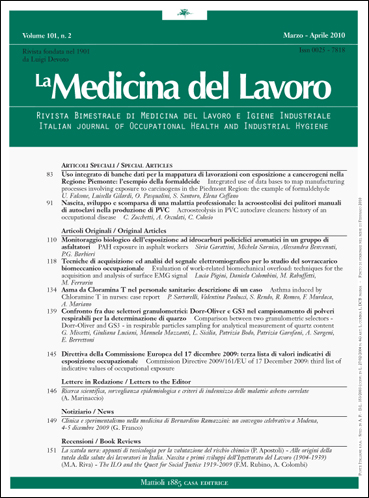Tecniche di acquisizione ed analisi del segnale elettromiografico per lo studio del sovraccarico biomeccanico occupazionale / Evaluation of work-related biomechanical overload: techniques for the acquisition and analysis of surface EMG signal
Contenuto principale dell'articolo
Keywords
Surface electromyography, work related muscle skeletal disorders, ergonomic redesign
Abstract
L’obiettivo di questa ricerca è stato quello di sviluppare un metodo per estrarre informazioni quantitative relative a fatica e livelli di attivazione muscolare attraverso l’analisi del segnale elettromiografico, e di integrarle con il metodo OCRA (OCcupational Repetitive Actions), indice per la valutazione del rischio da sovraccarico biomeccanico degli arti superiori. Quest’ultimo è un metodo che tiene conto dei principali fattori di rischio associati allo sviluppo di disturbi muscoloscheletrici degli arti superiori (UL WMSDs) connessi all’attività lavorativa ripetitiva come la postura, il movimento, la frequenza d’azione, i fattori organizzativi e lo sforzo muscolare. A differenza degli altri fattori di rischio che possono essere oggettivamente misurati nel corso dei sopralluoghi in azienda, lo sforzo muscolare è attualmente stimato solo tramite valutazione soggettiva (scala CR- 10 di Borg). A tale scopo sono stati implementati, specificatamente per un utilizzo “sul campo”, un nuovo sistema di acquisizione di elettromiografia di superficie e video sincronizzati, in grado di garantire un buon grado di ripetibilità inter e intra soggettiva, ed un software di elaborazione dedicato. La metodologia sviluppata è stata dapprima testata in laboratorio su un gruppo di 12 soggetti sani, studiando un compito ripetitivo eseguito in due differenti modalità (indice OCRA elevato/basso). In seguito tale metodologia è stata testata direttamente in ambito lavorativo per valutare differenti tipologie di strumenti per la potatura. I risultati del protocollo di laboratorio hanno evidenziato insorgenza di affaticamento per i gruppi muscolari maggiormente implicati nel movimento solo nel caso della prova ad alto indice di rischio (test di Bonferroni sulle MDF-frequenza mediana dello spettro-, p<0.05). Hanno evidenziato inoltre differenza significativa in termini di maggiore livello di attivazione, e quindi forza necessaria, nel caso della prova ad alto indice OCRA (test diWilcoxon su 10°-50°-90° percentile delle APDF (Amplitude Probability Distribution Function), p<0.05). Tali risultati oggettivano le differenze delle percezioni soggettive dello sforzo rilevate tramite scala di Borg. I risultati dell’applicazione aziendale dimostrano l’esportabilità del protocollo sviluppato anche in una realtà lavorativa e mostrano l’utilità dell’analisi nella valutazione delle differenze relative tra strumenti. Si può perciò concludere che i parametri calcolati, integrando le informazioni relative al fattore ‘Forza’ ottenibili attraverso il metodo OCRA con indici relativi allo sforzo dei singoli muscoli coinvolti nel lavoro, possono fornire obiettive informazioni per l’analisi e la progettazione ergonomica di strumenti e posti di lavoro produttivi.
Evaluation of work-related biomechanical overload: techniques for the acquisition and analysis of surface EMG signal
Objectives: The aim of this research was to obtain information concerning muscle fatigue and muscle activation levels by measuring quantitative parameters through the surface electromyographic signal, and use such information to integrate the OCRA (Occupational Repetitive Actions) method for risk assessment of upper limb biomechanical overload. Along with the main risk factors associated with the development of work-related
upper limb musculoskeletal disorders (UL WMSDs) like posture, movement, frequency of action and organizational factors, this method also takes into account the muscular effort. Unlike the other risk factors that can be directly measured during inspections on farms, muscular effort is currently estimated only via a subjective assessment scale (Borg CR-10 scale). Methods: A new apparatus and new procedures were implemented for synchronized EMG and video acquisition, which guarantee a high degree of inter- and intra-subject repeatability, and an ad hoc software for data elaboration was developed. They have been specifically designed for “on the field” applications. The methodology was first tested in the laboratory on a group of 12 healthy subjects, studying a repetitive task, running in two different ways, (high/low OCRA index) and interspersed with isometric tests for an indirect measurement of dynamic fatigue. The methodology was then tested in a working environment to compare the muscular effort required during the use of different types of tools for pruning. Results: Results of the laboratory protocol showed onset of fatigue for Anterior Deltoid, Middle Deltoid and Brachial Triceps muscles only for the high-risk index mode, as demonstrated by the significance of the Bonferroni tests (p < 0.05) on MDF (Median Frequency) calculated from isometric tests. They also showed significant differences in terms of higher level of muscle activation, and thus required force, in the case of high OCRA index work task compared to the one at low risk (Wilcoxon, p <0.05) for all analysed muscle groups with regard to 10th, 50th and 90th percentile of the APDF (Amplitude Probability Distribution Function). These results clearly defined the differences of subjectively perceived effort. The results of “field” application showed that the tested protocol was also easily exportable to a real working environment and that the numerical parameters extracted from the EMG signal can be a useful tool for evaluating effort levels of different muscles of the upper limb and for comparing different work tools, through effort indexes referred to single muscles. Conclusions: It can therefore be concluded that by integrating the information about the ‘FORCE’ factor in the OCRA method, the calculated parameters may provide objective information useful in analyzing and designing ergonomic tools and workplaces.






